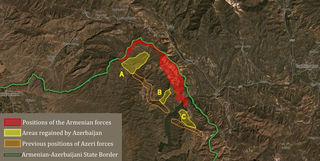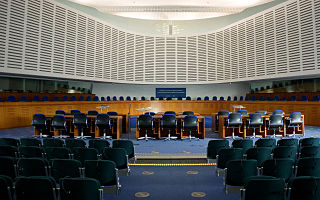 W
WThe Nagorno-Karabakh conflict is an ethnic and territorial conflict between Armenia and Azerbaijan over the disputed region of Nagorno-Karabakh, inhabited mostly by ethnic Armenians, and seven surrounding districts, inhabited mostly by Azerbaijanis until their expulsion during the Nagorno-Karabakh War, which are de facto controlled by the self-declared Republic of Artsakh, but are internationally recognized as de jure part of Azerbaijan. The conflict has its origins in the early 20th century, though the present conflict began in 1988, when the Karabakh Armenians demanded that Karabakh be transferred from Soviet Azerbaijan to Soviet Armenia. The conflict escalated into a full-scale war in the early 1990s.
 W
WThe 2008 Mardakert clashes began on March 4 after the 2008 Armenian election protests. It involved the heaviest fighting between ethnic Armenian and Azerbaijani forces over the disputed region of Nagorno-Karabakh since the 1994 ceasefire after the Nagorno-Karabakh War.
 W
WThe 2012 border clashes between the armed forces of Armenia and Azerbaijan took place in early June. The clashes resulted in casualties on both sides.
 W
WOn 12 November 2014, an Armenian Mil Mi-24 attack helicopter was shot down by Azerbaijani Armed Forces during the Nagorno-Karabakh conflict, killing all three crew members.
 W
WClashes on the Armenian–Azerbaijan border (Tavush–Qazakh) and the line of contact between the Nagorno-Karabakh and Azerbaijan started on 27 July 2014. Reported casualties of the clashes were some of the highest since the 1994 ceasefire agreement that ended the Nagorno-Karabakh War.
 W
WThe 2016 Nagarno-Karabakh conflict, also known as the Four-Day War, or April War, began along the Nagorno-Karabakh line of contact on 1 April 2016 with the Artsakh Defence Army, backed by the Armenian Armed Forces on one side and the Azerbaijani Armed Forces on the other.
 W
WGyunnyut Operation or Gyunnyut clashes began on 20 May 2018 between the Armenian Armed Forces and Azerbaijani Armed Forces. Clashes and subsequent military operations ended with Azerbaijan regaining several occupied villages and strategic positions within the Nakhchivan Autonomous Republic, these areas had previously been part of a no man's land between the Azerbajiani and Armenian lines. On the end of May, Nakhchivan Separate Combined-arms Army regained control of Gyunnut, a village in Sharur District that has been completely destroyed by the Armenian forces in 1992, and two strategic positions, Khunutdagh and Aghbulag. Azerbaijani Armed Forces also regained control of and took new positions on Kyzylkaya and Mehridagh strategic positions. They also reportedly took new positions in a previously unoccupied neutral zone in Nakhchivan near Armenian village of Areni in Vayots Dzor Province.
 W
WThe July 2020 Armenian–Azerbaijani clashes began on 12 July 2020 between the Armenian Armed Forces and Azerbaijani Armed Forces. Initial clashes occurred near Movses in Tavush Province of Armenia, and Ağdam in Tovuz District of Azerbaijan at the Armenian–Azerbaijani state border.
 W
WThe bombing of Ganja took place on 11 October 2020, at approximately 02:00 local time, when Armenian Armed Forces units fired on the city of Ganja, Azerbaijan. As a result of the attack, ten people died and more than 40 were injured. Among the injured were minors. During the attack, a variety of infrastructure in the city, which is the second largest in Azerbaijan, was destroyed, including an apartment block, and structures and vehicles in the vicinity of the explosion were seriously damaged. The attack was one of the first major violations of the ceasefire, signed a day earlier, to attempt to halt the 2020 Nagorno-Karabakh conflict, and one of the first serious attacks in the conflict outside the Nagorno-Karabakh region.
 W
WThe 2020 Nagorno-Karabakh conflict is an ongoing armed conflict between Azerbaijan and the self-proclaimed Republic of Artsakh, supported by Armenia, in the disputed Nagorno-Karabakh region. It is the latest escalation of the unresolved Nagorno-Karabakh conflict over the territory, which is internationally recognised as part of Azerbaijan, but mostly governed by Artsakh, a breakaway state with an Armenian ethnic majority.
 W
WAnti-Armenian sentiment or Armenophobia is widespread in Azerbaijan, mainly due to the conflict over Nagorno-Karabakh. According to the European Commission against Racism and Intolerance (ECRI), Armenians are "the most vulnerable group in Azerbaijan in the field of racism and racial discrimination." According to a 2012 opinion poll, 91% of Azerbaijanis perceive Armenia as "the biggest enemy of Azerbaijan." The word "Armenian" (erməni) is widely used as an insult in Azerbaijan. Stereotypical opinions circulating in the mass media have their deep roots in the public consciousness."
 W
WThe anti-Azerbaijani sentiment or Azerbaijanophobia has been mainly rooted in several countries, most notably in Armenia and Iran, where anti-Azerbaijani sentiment has sometimes led to violence racial incidents.
 W
WArmenia has participated in the Eurovision Song Contest, a pan-European music competition, since 2006, while Azerbaijan has participated since 2008. The continuing conflict between the two countries over the region of Nagorno-Karabakh, which is considered to be a de jure part of Azerbaijan by the United Nations, but has been under control of the Armenia-backed de facto Nagorno-Karabakh Republic since 1993, has affected the Eurovision Song Contest on several occasions.
 W
WArmenians in Azerbaijan are the Armenians who lived in great numbers in the modern state of Azerbaijan and its precursor, Soviet Azerbaijan. According to the statistics, about 500,000 Armenians lived in Soviet Azerbaijan prior to the outbreak of Nagorno Karabakh War in 1988. Most of the Armenian-Azerbaijanis however had to flee the republic, like Azerbaijanis in Armenia, in the events leading up to the Nagorno-Karabakh War, a result of the ongoing Armenian-Azerbaijani conflict. Atrocities directed against the Armenian population have reportedly taken place in Sumgait, Ganja and Baku. Today the vast majority of Armenians in Azerbaijan live in territory controlled by the break-away region Nagorno-Karabakh which declared its unilateral act of independence in 1991 under the name Nagorno-Karabakh Republic but has not been recognised by any country, including Armenia.
 W
WArmenians once formed a sizable community in Baku, the current capital of the Republic of Azerbaijan. Though the date of their original settlement is unclear, Baku's Armenian population swelled during the 19th century, when it became a major center for oil production and offered other economic opportunities to enterprising investors and businessmen. Their numbers remained strong into the 20th century, despite the turbulence of the Russian Revolutions of 1917, but almost all the Armenians fled the city between 1988 and January 1990. By the beginning of January 1990, only 50,000 Armenians remained in Baku compared to a quarter million in 1988; most of these left after being targeted in a pogrom that occurred prior to the dissolution of the Soviet Union and the early stages of the Nagorno-Karabakh War.
 W
WAzerbaijanis in Armenia were once the largest ethnic minority in the country, but have been virtually non-existent since 1988–1991 when most either fled the country or were pushed out as a result of the Nagorno-Karabakh War and the ongoing conflict between Armenia and Azerbaijan. UNHCR estimates the current population of Azeris in Armenia to be somewhere between 30 and a few hundred people, with majority of them living in rural areas and being members of mixed couples, as well as elderly or sick. Most of them are reported to have changed their names to maintain low profiles to avoid discrimination.
 W
WChiragov v. Armenia was an international human rights case regarding the rights to property to Azeri nationals in the Nagorno-Karabakh region of former Soviet Azerbaijan. The judgment of the Grand Chamber of the European Court of Human Rights on the case originated in an application against the Republic of Armenia lodged with the Court under Article 34 of the Convention for the Protection of Human Rights and Fundamental Freedoms by six Azerbaijani nationals on 6 April 2005. The applicants alleged, in particular, that they were prevented from returning to the district of Lachin in territory occupied by the respondent Government, that they were thus unable to enjoy their property and homes located there, and that they had not received any compensation for their losses.
 W
WThe Line of Contact separates the Armenian forces and the Azerbaijan Armed Forces in the Nagorno-Karabakh conflict. It was formed in the aftermath of the May 1994 ceasefire that ended the Nagorno-Karabakh War (1988–94). The mountain range of Murovdag is the northern part of the line of contact and is essentially a natural border between the two forces. The length of the line of contact is between 180 kilometres (110 mi) and 200 kilometres (120 mi).
 W
WThe Nagorno-Karabakh War, referred to in Armenia as the Artsakh Liberation War, was an ethnic and territorial conflict that took place in the late 1980s to May 1994, in the enclave of Nagorno-Karabakh in southwestern Azerbaijan, between the majority ethnic Armenians of Nagorno-Karabakh backed by Armenia, and the Republic of Azerbaijan. As the war progressed, Armenia and Azerbaijan, both former Soviet Republics, entangled themselves in protracted, undeclared mountain warfare in the mountainous heights of Karabakh as Azerbaijan attempted to curb the secessionist movement in Nagorno-Karabakh. The enclave's parliament had voted in favor of uniting itself with Armenia and a referendum, boycotted by the Azerbaijani population of Nagorno-Karabakh, was held, whereby most of the voters voted in favor of independence. The demand to unify with Armenia began in a relatively peaceful manner in 1988; in the following months, as the Soviet Union disintegrated, it gradually grew into an increasingly violent conflict between Armenians and Azerbaijanis, resulting in ethnic cleansing, with Sumgait pogrom (1988), Baku pogrom (1990) and Khojaly Massacre (1992) being notable examples. Inter-ethnic clashes between the two broke out shortly after the parliament of the Nagorno-Karabakh Autonomous Oblast (NKAO) in Azerbaijan voted to unify the region with Armenia on 20 February 1988. The declaration of secession from Azerbaijan was the final result of a territorial conflict regarding the land. As Azerbaijan declared its independence from the Soviet Union and removed the powers held by the enclave's government, the Armenian majority voted to secede from Azerbaijan and in the process proclaimed the unrecognized Republic of Nagorno-Karabakh.